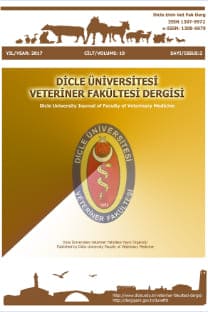Saha Şartlarında Tedavi Edilen Retensio Sekundinarum Vakalarının Fertilite Üzerine Etkileri
Anahtar Kelimeler:
Fertilite, Ġnek, Metritis, Retensio Sekundinarum
The Effects on Fertility of Retentio Secundinarum Cases Which Treated on Field Conditions
In this study, the evaluation of 389 retentio secundinarum cases was presented which were treated by clinician veterinarians of Ayvet Veterinary Clinic on field conditions for the period 2002-2009. Followed 149 cases’ fertility results were evaluated from 389 retentio secundinarum cases which was recorded on clinic animal data-base. Calving-first insemination interval, calving-pregnancy interval, insemination index, re-inseminations and pregnancy rates were followed of these 149 cases. On treated cows which had retentio secundinarum cases; it was determined that calving-first insemination interval was 117 days, calving-pregnancy interval was 148 days and the insemination index 1,47 on average. The pregnancy was achieved on first insemination for 60 (40,26%) cows, on second insemination for 28 (18,8%) cows and on third insemination for 9 (6,04%) cows. The pregnancy was achieved on 97 (65,1%) cows. The pregnancy wasn’t achieved for 52 (34,9%) cows in spite of inseminating for three times. Otherwise, the results of fertility were compared for three different parenterally administrated antibiotic treatment on the number of 58 retention cases which had been complicated with metritis. Cephalexin monohydrate for 22 cows, Dihydrostreptomycine sulphate+Procain Penicillin for 19 cows and Gentamycine sulphate for 17 cows were administrated for 4 days according to prospectus doses parenterally. It was determined on parenterally antibiotic administrated cows which had been complicated with metritis that calving-pregnancy insemination interval were 105 days for Cephalexin monohydrate, 121 days for Dihydrostreptomycine sulphate+Procain Penicilin, 136 days for Gentamycine sulphate and 120 days for generally on average. As conclusion, this study might be beneficial for assessing the loss of fertility on field-based retentio secundinarum treatments.
Keywords:
Cow, Fertility, Metritis, Retentio Secundinarum,
- ISSN: 1307-9972
- Yayın Aralığı: Yılda 2 Sayı
- Başlangıç: 2008
- Yayıncı: Dicle Üniversitesi Veteriner Fakültesi
Sayıdaki Diğer Makaleler
Berna Güney Saruhan, M. Erdem Akbalık, Hakan Sağsöz, M. Aydın Ketani
Marek Hastalığı Teşhisinde Histokimyasal ve Histopatolojik Bulguların Değerlendirilmesi
M. Kemal Çiftçi, İlhami Çelik, Mehmet Tuzcu, Emrah Sur, Ertan Oruç
Sığırlarda Karın Şişkinliklerinde Müdahale Yöntemleri ve İlaç Uygulamaları
Saha Şartlarında Gerçekleştirilen Suni Tohumlama Uygulamalarının Retrospektif Analizi
Saha Şartlarında Tedavi Edilen Retensio Sekundinarum Vakalarının Fertilite Üzerine Etkileri
